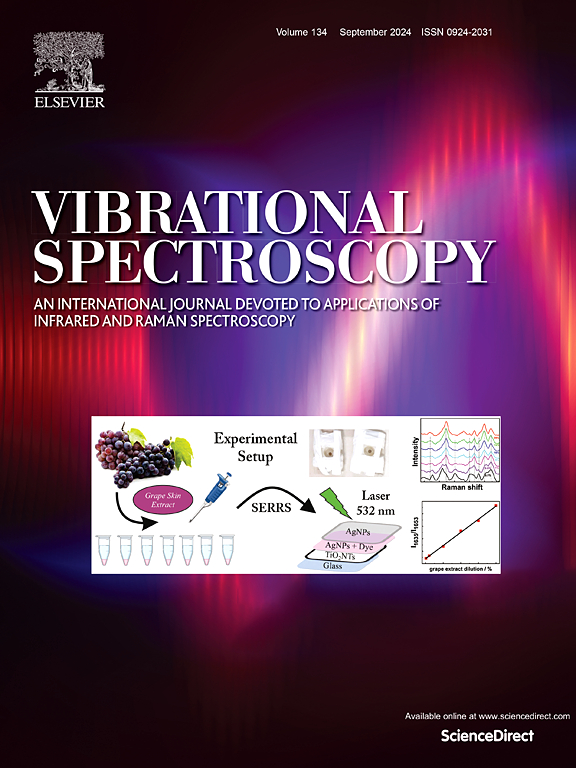Spectroscopic profiling of lipid and protein alterations in kidney tissue induced by coated MoS2 quantum dots
IF 3.1
3区 化学
Q2 CHEMISTRY, ANALYTICAL
引用次数: 0
Abstract
Molybdenum disulfide (MoS2) quantum dots (QDs) possess unique physicochemical properties that make them attractive for biomedical applications. However, their interactions with biological tissues at the molecular level remain insufficiently understood. In this study, we employed spectroscopic techniques to investigate molecular alterations in the lipids and proteins of murine kidney tissue following exposure to coated MoS2 QDs. Healthy male SWR/J mice were divided into control and treated groups, with the latter receiving daily doses of encapsulated QDs. Spectroscopic analyses revealed subtle yet consistent changes in lipid composition and organization, evidenced by shifts in CH₂ and CH₃ stretching vibrations and decreased intensity in lipid-associated Raman bands. FTIR spectra also indicated a reduction in carbonyl ester content, suggesting lipid peroxidation effects. Additionally, minor perturbations in aromatic amino acid bands and heme-associated features were observed in UV-Vis spectra, indicating possible interactions with protein residues; however, no significant secondary structural changes in proteins were detected. These results demonstrate the utility of spectroscopic approaches in revealing molecular alterations induced by coated MoS2 QDs in kidney tissue. Additionally, these findings confirm the importance of utilizing integrated spectroscopic approaches for evaluating the biocompatibility and safety of emerging nanomaterials at the molecular level.
包被二硫化钼量子点诱导肾组织脂质和蛋白质改变的光谱分析
二硫化钼(MoS2)量子点(QDs)具有独特的物理化学性质,使其在生物医学应用中具有吸引力。然而,它们在分子水平上与生物组织的相互作用仍然不够清楚。在这项研究中,我们利用光谱技术研究了暴露于包被二硫化钼量子点后小鼠肾组织中脂质和蛋白质的分子变化。将健康雄性SWR/J小鼠分为对照组和治疗组,治疗组给予每日剂量的QDs胶囊。光谱分析揭示了脂质组成和组织的微妙而一致的变化,证明了CH₂和CH₃拉伸振动的变化和脂质相关拉曼带强度的降低。FTIR光谱还显示羰基酯含量降低,表明脂质过氧化作用。此外,在紫外可见光谱中观察到芳香氨基酸带和血红素相关特征的轻微扰动,表明可能与蛋白质残基相互作用;然而,在蛋白质中未检测到明显的二级结构变化。这些结果证明了光谱方法在揭示包被二硫化钼量子点在肾组织中引起的分子改变方面的效用。此外,这些发现证实了利用综合光谱方法在分子水平上评估新兴纳米材料的生物相容性和安全性的重要性。
本文章由计算机程序翻译,如有差异,请以英文原文为准。
求助全文
约1分钟内获得全文
求助全文
来源期刊

Vibrational Spectroscopy
化学-分析化学
CiteScore
4.70
自引率
4.00%
发文量
103
审稿时长
52 days
期刊介绍:
Vibrational Spectroscopy provides a vehicle for the publication of original research that focuses on vibrational spectroscopy. This covers infrared, near-infrared and Raman spectroscopies and publishes papers dealing with developments in applications, theory, techniques and instrumentation.
The topics covered by the journal include:
Sampling techniques,
Vibrational spectroscopy coupled with separation techniques,
Instrumentation (Fourier transform, conventional and laser based),
Data manipulation,
Spectra-structure correlation and group frequencies.
The application areas covered include:
Analytical chemistry,
Bio-organic and bio-inorganic chemistry,
Organic chemistry,
Inorganic chemistry,
Catalysis,
Environmental science,
Industrial chemistry,
Materials science,
Physical chemistry,
Polymer science,
Process control,
Specialized problem solving.
 求助内容:
求助内容: 应助结果提醒方式:
应助结果提醒方式:


